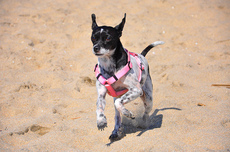Sun protection for pets is smart and easy, but be careful with potentially toxic products

Pets can get sunburn too, and that can worsen existing skin conditions.
flickr photo by Lifesupercharger
A walk along the shore, soaking up some rays and enjoying the sand between the toes is something that we here in Michigan relish each year during our all too short summers. When the nice weather hits it's all about the outdoor activities — not only for us, but our pets.
These days, it's second nature to reach for the sunscreen before we head out. It's a must to protect our skin from UVA and UVB rays.
But what about our pets?
They need sun protection, too, and you might be surprised to learn that using sunscreen formulated for humans is perfectly acceptable.
Before you roll your eyes and scoff, remember that skin is skin, and while not all pets are equally at risk, there are some instances where a little extra prevention goes a long way.
Pets with light skin, short and thinning fur or fur loss are especially susceptible to the sun's rays.
Sunburn can even exacerbate skin allergies and hotspots.
Many folks shave their dogs in the summer to help aid in keeping them cooler, and shaved pets are in even greater need of sun protection.
Pets like to roll on their backs and expose their tummies, so applying sunscreen there is essential. Simply walking along the water or near concrete allows UV rays to reflect off and onto bare skin. The groin area, inside the legs is especially tender, as is the bridge of the nose and tips of the ears.
So, be sure to apply 20 minutes or so before going out for optimum protection, and reapply when the sun is its strongest, mid-morning to midday, every four to six hours.
It is assumed that SPF ratings are the same for dogs, cats and humans alike, and using a sweatproof/waterproof formula is recommended to help avoid ingestion, since pets have a tendency to groom themselves and will lick it off.
It's recommended that a you employ a apply and distract strategy for a few minutes to avoid ingestion.
Also, non-greasy formulations are a great choice. All major sunscreens are considered safe in small amounts — including those that contain avobenzone (Parsol 1789).
Do not use formulas that include zinc in their ingredient lists. Sunscreens containing salicylates should not be used on cats, as there is a potential for toxicity.
If your pet needs a full body cover, or if you are unclear about your pets' specific situation, talk to your veterinarian. And remember, sun exposure happens year-round. If your pet is outside for extended periods of time in the sun even in the winter, sunscreen is needed then, too.
Lorrie Shaw leads the pets section for AnnArbor.com and is owner of Professional Pet Sitting. Shoot her an email, contact her at 734-904-7279 or follow her adventures on Twitter.


Comments
RunsWithScissors
Wed, Jun 6, 2012 : 1:33 a.m.
This is great news! My cats had me convinced that I needed to follow them around with a parasol for sun protection. And as soon as I teach them to read, they'll find out that SPF 30 is all they need.